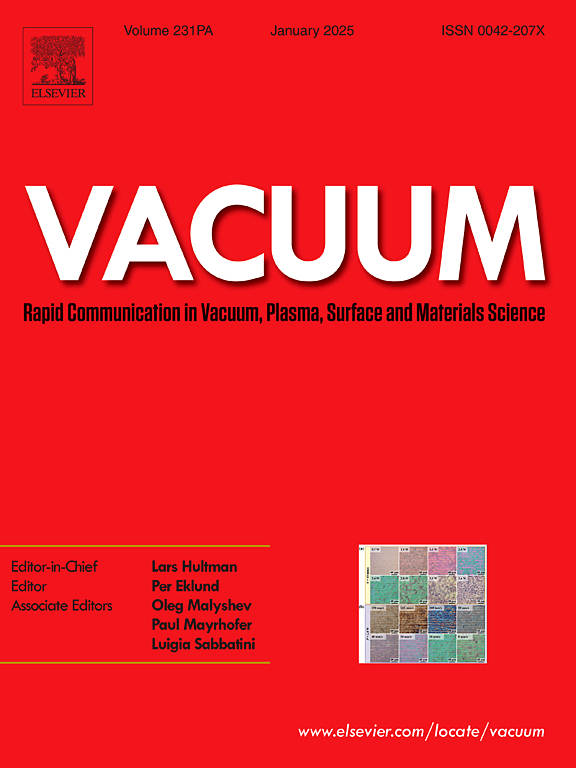Atomic layer deposition of tin monosulfide thin film using Sn(acac)2 and H2S
IF 3.8
2区 材料科学
Q2 MATERIALS SCIENCE, MULTIDISCIPLINARY
引用次数: 0
Abstract
In this study, we deposited tin monosulfide (SnS) thin film using Tin(II) 2,4-pentanedionate [Sn(acac)2] precursor and hydrogen sulfide (H2S) reactant. And we performed post annealing to improve the crystallinity of SnS thin films. The process window was 130 °C–150 °C, and the growth rate was 0.34 Å/cycle. To investigate crystallinity and the phase of SnS thin films, grazing incidence x-ray diffraction (GI-XRD) and Raman spectroscopy were performed. SnS thin films showed a single orthorhombic phase after annealing. In addition, transmission electron microscopy (TEM) was utilized to confirm the two-dimensional (2D) layered structure of SnS thin films. Post-annealed SnS thin film clearly showed a 2D layered structure. X-ray photoelectron spectroscopy (XPS) was performed to confirm the bonding state of the thin film. The results indicated that the SnS thin film only shows binding energies corresponding to the oxidation states of Sn2+ in the Sn 3d spectra and S2- in the S 2p spectra. Ultraviolet–visible (UV–vis) spectroscopy and ultraviolet photoelectron spectroscopy (UPS) were performed to confirm the optical properties and to calculate the band structure of the thin film. All of SnS thin film showed a p-type characteristic. The post-annealed SnS thin films exhibited better electric properties, confirmed by Hall measurement.
使用 Sn(acac)2 和 H2S 进行单硫化锡薄膜的原子层沉积
在这项研究中,我们使用 2,4-戊二酸锡[Sn(acac)2]前驱体和硫化氢(H2S)反应物沉积了单硫化锡(SnS)薄膜。我们还进行了后退火处理,以提高 SnS 薄膜的结晶度。工艺窗口为 130 ℃-150 ℃,生长速率为 0.34 Å/周期。为了研究 SnS 薄膜的结晶度和相位,我们进行了掠入射 X 射线衍射 (GI-XRD) 和拉曼光谱分析。退火后,SnS 薄膜显示出单一的正交相。此外,还利用透射电子显微镜(TEM)确认了 SnS 薄膜的二维(2D)层状结构。退火后的 SnS 薄膜明显呈现出二维层状结构。X 射线光电子能谱(XPS)用于确认薄膜的键合状态。结果表明,在 Sn 3d 光谱中,SnS 薄膜只显示出与 Sn2+ 氧化态相对应的结合能,而在 S 2p 光谱中,则显示出与 S2- 氧化态相对应的结合能。紫外-可见(UV-vis)光谱和紫外光电子能谱(UPS)被用来确认薄膜的光学特性和计算薄膜的能带结构。所有的 SnS 薄膜都显示出 p 型特征。经霍尔测量证实,退火后的 SnS 薄膜具有更好的电特性。
本文章由计算机程序翻译,如有差异,请以英文原文为准。
求助全文
约1分钟内获得全文
求助全文
来源期刊

Vacuum
工程技术-材料科学:综合
CiteScore
6.80
自引率
17.50%
发文量
0
审稿时长
34 days
期刊介绍:
Vacuum is an international rapid publications journal with a focus on short communication. All papers are peer-reviewed, with the review process for short communication geared towards very fast turnaround times. The journal also published full research papers, thematic issues and selected papers from leading conferences.
A report in Vacuum should represent a major advance in an area that involves a controlled environment at pressures of one atmosphere or below.
The scope of the journal includes:
1. Vacuum; original developments in vacuum pumping and instrumentation, vacuum measurement, vacuum gas dynamics, gas-surface interactions, surface treatment for UHV applications and low outgassing, vacuum melting, sintering, and vacuum metrology. Technology and solutions for large-scale facilities (e.g., particle accelerators and fusion devices). New instrumentation ( e.g., detectors and electron microscopes).
2. Plasma science; advances in PVD, CVD, plasma-assisted CVD, ion sources, deposition processes and analysis.
3. Surface science; surface engineering, surface chemistry, surface analysis, crystal growth, ion-surface interactions and etching, nanometer-scale processing, surface modification.
4. Materials science; novel functional or structural materials. Metals, ceramics, and polymers. Experiments, simulations, and modelling for understanding structure-property relationships. Thin films and coatings. Nanostructures and ion implantation.
 求助内容:
求助内容: 应助结果提醒方式:
应助结果提醒方式:


